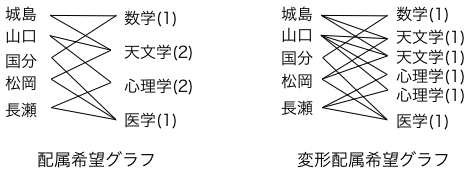Pythonプログラミング(ステップ9・クラスとオブジェクト・グラフのマッチング)
このページでは、オブジェクトを使った例として、テキストの「4.4 学生を配属する」の実装について考える。
1.学生配属問題
参考書の「4.4 学生を配属する」(p.134)では、 人数制限のある複数の授業に、最大限に本人の希望を汲み入れながら、学生を振り分ける方法について述べられている。 ここでは、その内容を繰り返すことはしないが、解くべき問題を要約すると、
- $N$人の新入生の集合がある:$X=\{ x_1, x_2, \cdots, x_N\}$
- $M$個の授業(クラス)があって($C = \{ c_1, c_2, \cdots, c_M\}$)、 各クラスには定員が設けられている。ここで、クラス$c$の定員を $m(c)$ とする。
- 学生毎に最大$L$まで、配属の希望を出すことができる。
- これらの条件のもとで、希望先に配属される学生の数が最大となるように、学生の配属先をひとつずつ決める。
となる。
もちろん、学生の希望が100%叶うとは限らない。極端な場合、全員がひとつのクラスを希望し、 クラス定員が学生数より少なければ、多くの者は、希望しないクラスに配属せざるを得ない。
2.データの表現
まず、新入生の集合をPythonのリストで表すことにしよう。汎用性を持たせ、氏名以外の属性(配属先希望など)も扱えるよう、Studentというクラスを定義してみる:
L=2
class Student:
def __init__(self,name,choices):
self.name=name
self.choices=choices # 配属先希望リスト
if len(choices)>L:
print("希望数が多すぎます")
次に、授業のほうは(Classというクラスを使いたいところではあるが、名前が衝突するので)Lessonというクラスを使って
class Lesson: def __init__(self,title,capacity): self.title=title self.capacity=capacity # 定員
としてみる。すると、参考書 図4.8の状況は
c1 = Lesson("数学",1)
c2 = Lesson("天文学",2)
c3 = Lesson("心理学",2)
c4 = Lesson("医学",1)
C = [c1,c2,c3,c4]
x1 = Student("城島",[c1,c2])
x2 = Student("山口",[c2,c3])
x3 = Student("国分",[c1,c4])
x4 = Student("松岡",[c2,c4])
x5 = Student("長瀬",[c3,c4])
X = [x1,x2,x3,x4,x5]
のようなコードで表現できる。
3.配属数が1のダミーの授業に分解する
続いて、定員が $m$ のクラスを、定員1で $m$ 個の(ダミーの)クラスに「分解」する。
以下のコードでは、ダミーのクラスがリスト CP に生成される:
リスト.extend(別のリスト)で、「リスト」に「別のリスト」が連結される
import copy
CP=[ ]
for c in C:
newlist=[ ]
for i in range(c.capacity):
cp = copy.copy(c)
cp.capacity=1
newlist.append(cp)
CP.extend(newlist)
for x in X:
for z in x.choices:
if z is c:
x.choices.remove(z)
x.choices.extend(newlist)
break
ここで、オブジェクトをコピーする際の重要な注意点がある。変数cにオブジェクトがセットされているとき、
代入 cp = c を行っても、そのオブジェクトの複製が生成されるわけではない。
変数にセットされているのは、オブジェクトの参照先(オブジェクトがどこにあるか)なので、「住所」だけコピーしても、
オブジェクト(家)が複製されるわけではない。
ここでは「浅いコピー」を行っている
上のコードでは、オブジェクトそのものの複製を生成したいので、代わりにcp = copy.copy(c)と記述している。
copyモジュール を使うことで、オブジェクトの実体を複製し、その参照先を cp にセットできる。
そうして、新たなリスト CP の各オブジェクトは、定員1名ずつの新しいLessonクラスのオブジェクトが格納されてる。
4.データから「変形配属希望グラフ」を生成する
「配属先希望グラフ」を表現するために、二部グラフを表現するクラスを定義する。
ここで、uは「左側」、vは「右側」の頂点に対応づけることを想定している。
class BGraph:
"""a bipartile graph representation by Python """
class Vertex:
def __init__(self,name):
self.name=name
self.link=[ ] # list of [Vertex]
self.label=None
def __init__(self):
self.us=[ ]
self.vs=[ ]
def create_vertex_u(self,name):
u = BGraph.Vertex(name)
self.us.append(u)
def create_vertex_v(self,name):
v = BGraph.Vertex(name)
self.vs.append(v)
def append_link(self,v,a):
if a in v.link:
print("already connected")
else:
v.link.append(a)
def connect_vertex(self,u,v):
self.append_link(u,v)
self.append_link(v,u)
このようにクラスBGraphを定義すると、学生の希望リスト$X$と授業のリスト$CP$(定員1名)を使って、 以下のコードで二部グラフが生成できる。
dict={}
for c in CP:
v = g.create_vertex_v(c.title)
dict[c]=v
for x in X:
u = g.create_vertex_u(x.name)
for c in x.choices:
v = dict[c]
g.connect_vertex(u,v)
ここで、希望リスト中のLessonクラスのオブジェクトと、BGraph中のVertexクラスのオブジェクトとの 対応関係を記憶しておくため、「辞書」dictを用いている。
5.グラフの最大マッチングを求める
ここでは、教科書で説明されている$M-$交互道のアイデアに沿って、最大マッチングを求めるコードをさらに追加した例を示す。 これまでに登場したコードも中に含まれる。
# coding: utf-8
import copy
L=2
class Student:
def __init__(self,name,choices):
self.name=name
self.choices=choices # 配属先希望リスト
if len(choices)>L:
print("希望数が多すぎます")
class Lesson:
def __init__(self,title,capacity):
self.title=title
self.capacity=capacity # 定員
class BGraph:
"""a bipartile graph representation by Python """
class Vertex:
def __init__(self,name):
self.name=name
self.link=[ ] # list of [Vertex]
self.label=None
def __init__(self):
self.us=[ ] # list of U
self.vs=[ ] # list of V
def create_vertex_u(self,name):
u = BGraph.Vertex(name)
self.us.append(u)
return u
def create_vertex_v(self,name):
v = BGraph.Vertex(name)
self.vs.append(v)
return v
def append_link(self,v,a):
if a in v.link:
print("already connected")
else:
v.link.append(a)
def connect_vertex(self,u,v):
self.append_link(u,v)
self.append_link(v,u)
def is_in_u(self,x):
if x in self.us:
return True
else:
return False
def is_in_v(self,x):
if x in self.vs:
return True
else:
return False
def remove_all_labels(self):
for x in self.us:
x.label=None
for x in self.vs:
x.label=None
# a Python version of the algorithm described in
# http://www.csl.mtu.edu/cs4321/www/Lectures/
# Lecture%2022%20-%20Maximum%20Matching%20in%20Bipartite%20Graph.htm
def perform_matching(self):
matching=[ ]
queue=[x for x in self.vs]
while len(queue)>0:
w = queue.pop()
if self.is_in_v(w):
for u in w.link:
u_matched=set()
for x,y in matching:
u_matched.add(y)
if u not in u_matched:
matching.append([w,u])
v=w
while v.label is not None:
u = v.label
matching.remove([v,u])
v = u.label
matching.append([v,u])
self.remove_all_labels()
v_matched=set()
for x,y in matching:
v_matched.add(x)
v_free = set(self.vs) - v_matched
queue=list(v_free)
break
else:
if ([w,u] not in matching) and u.label is None:
u.label = w
queue.append(u)
else:
for v,u in matching:
if u is w:
v.label = w
queue.append(v)
break
return matching
# end of BGraph
# メイン部
c1 = Lesson("数学",1)
c2 = Lesson("天文学",2)
c3 = Lesson("心理学",2)
c4 = Lesson("医学",1)
C = [c1,c2,c3,c4]
x1 = Student("城島",[c1,c2])
x2 = Student("山口",[c2,c3])
x3 = Student("国分",[c1,c4])
x4 = Student("松岡",[c2,c4])
x5 = Student("長瀬",[c3,c4])
X = [x1,x2,x3,x4,x5]
# 各クラスを定員1名に分解し、CPにセットする
CP=[ ]
for c in C:
newlist=[ ]
for i in range(c.capacity):
cp = copy.copy(c)
cp.capacity=1
newlist.append(cp)
CP.extend(newlist)
for x in X:
for z in x.choices:
if z is c:
x.choices.remove(z)
x.choices.extend(newlist)
break
# XとCPから二部グラフを生成する
g = BGraph()
dict={}
for c in CP:
v = g.create_vertex_v(c.title)
dict[c]=v
for x in X:
u = g.create_vertex_u(x.name)
for c in x.choices:
v = dict[c]
g.connect_vertex(u,v)
# 最大マッチングを求める
matching=g.perform_matching()
# 結果を出力する
for v,u in matching:
print(u.name,"--",v.name)
 練習:コードの動作確認
練習:コードの動作確認
仮の学生とクラスを想定し、上記のコードをそれに合わせて変更した上で、動作確認を行いなさい。
